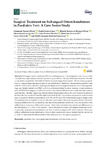Mostrar o rexistro simple do ítem
Surgical Treatment on Subungual Osteochondromas in Paediatric Feet: A Case Series Study
| dc.contributor.author | Navarro Flores, Emmanuel | |
| dc.contributor.author | López-López, Daniel | |
| dc.contributor.author | Becerro-de-Bengoa-Vallejo, Ricardo | |
| dc.contributor.author | Losa Iglesias, Marta Elena | |
| dc.contributor.author | Romero Morales, Carlos | |
| dc.contributor.author | San Antolín, Marta | |
| dc.contributor.author | Calvo-Lobo, César | |
| dc.contributor.author | Bautista-Casasnovas, Adolfo Laureano | |
| dc.date.accessioned | 2020-05-07T10:39:46Z | |
| dc.date.available | 2020-05-07T10:39:46Z | |
| dc.date.issued | 2020-04 | |
| dc.identifier.citation | Navarro-Flores, E.; López-López, D.; Becerro-de-Bengoa-Vallejo, R.; Losa-Iglesias, M.E.; Romero-Morales, C.; San Antolín-Gil, M.; Calvo-Lobo, C.; Bautista-Casasnovas, A.L. Surgical Treatment on Subungual Osteochondromas in Paediatric Feet: A Case Series Study. J. Clin. Med. 2020, 9, 1122. | es_ES |
| dc.identifier.issn | 2077-0383 | |
| dc.identifier.uri | http://hdl.handle.net/2183/25513 | |
| dc.description.abstract | [Abstract] Subungual osteochondroma (SO) is an infrequent and non-malignant bone tumour of the distal phalanx, especially prominent in paediatric populations. The aim of this research was to describe a case series of paediatric feet with SO which received surgical treatments. The secondary purpose was to compare these descriptive data by sex distribution. Methods: Twenty-three paediatric feet with SO confirmed by clinical or radiological features received surgical treatment. Socio-demographic (age, sex, height, weight and BMI) and clinical features (side, location, tumour or pain presence, and nail lift before surgery, as well as recurrence and adverse effects at one month after intervention) were reported. Results: Regarding clinical features before intervention, the most frequent locations of SO were the first toe (86.8%) and the right lower limb (56.5%). In addition, the presence of the tumour, pain and nail lift showed a prevalence of 91.3%, 69.5% and 47% of the study sample, respectively. Considering clinical features at one month after intervention, the most frequent adverse effect was the pain presence (69.5%). In addition, one case (4.4%) presented ulceration. Only one patient (4.4%) suffered from recurrence with a new tumour. There were not statistically significant differences by sex distribution (p > 0.05). Conclusions: This novel study showed that surgery treatment for SO in paediatric populations presented a very low recurrence degree with minor adverse effects and without differences by sex distribution. Thus, further randomized clinical trials should be carried out in order to determine the effectiveness of this intervention in this special population. | es_ES |
| dc.language.iso | eng | es_ES |
| dc.publisher | MDPI AG | es_ES |
| dc.relation.uri | https://doi.org/10.3390/jcm9041122 | es_ES |
| dc.rights | Atribución 3.0 España | es_ES |
| dc.rights.uri | http://creativecommons.org/licenses/by/3.0/es/ | * |
| dc.subject | Paediatric foot | es_ES |
| dc.subject | Subungual osteochondroma | es_ES |
| dc.subject | Children | es_ES |
| dc.subject | Bone tumour | es_ES |
| dc.title | Surgical Treatment on Subungual Osteochondromas in Paediatric Feet: A Case Series Study | es_ES |
| dc.type | info:eu-repo/semantics/article | es_ES |
| dc.rights.access | info:eu-repo/semantics/openAccess | es_ES |
| UDC.journalTitle | Journal of Clinical Medicine | es_ES |
| UDC.volume | 9 | es_ES |
| UDC.issue | 4 | es_ES |
Ficheiros no ítem
Este ítem aparece na(s) seguinte(s) colección(s)
-
GI-UDISAP - Artigos [196]






